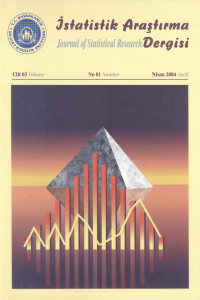Öz
We estimate Value at Risk (VaR) using the extreme value theory. VaR is a method emerging recently in risk management. Extreme value theory models the tails of the return distribution rather than the whole distribution, which is more meaningful during the volatile market conditions, under which the distribution of returns almost has fat tail. Risk managers are more concerned on the tail. The limit distribution of extreme returns observed over a long time period is independent of the distribution of returns itself. In this case, it is not necessary to assume a specific distribution for returns, which is a great advantage of extreme value theory on VaR calculation. In contrast, variance-covarience method with normality assumption usually under estimates the risk value. The maxima and minima series from İstanbul stock Exchange index returns are found to be satisfactorily modelled within an extreme value framework and the Var measures generated with this method are found to be much different from those generated by variance-covariance method. The approach based extreme value theory to compute VaR cover market conditions ranging from usual environment considered by the ordinary VaR methods to the financial crises which are focus of stress testing. Moreover, extreme value approach can also be used to calculate credit VaR.
Anahtar Kelimeler
Value-at Risk(VaR) Extreme Value Theory Generalized Extreme Value Theory Heavy Tails Parameter Estimation
Kaynakça
- Bassle Committee on Banking Supervision (1996), Ammendment to Capital Accord to Incorparate Market Risks, http://www.bis.org.
- BEIRLANT, J., TEUGELS, J., VYNCKIER, P.(1996), Pratical Analysis of Extreme Values, Leuven. University Press, Leuven.
- CRRISTOFFERSEN. P.F. (1998), Evaluation interval Forecasts. International Economic Review, 39. (4). 841-862.
- DOWD. K.(I998), Beyond Value at Risk, Wiley, Chichester.
- DUFFIE. D., PAN, J., (1997), an Overview of Value - at Risk, The Journal of Derivatives, Spring, 7-49.
- EMBRECHTS, P., KLUPPELBERG, C., MIKOSCH, T.(1997), Modelling Extreme Events for insurance and Finance, Springer – Verlag, Berlin.
- FISHER, R.A., TlPPETT, L.H.C. (1928), Limiting Forms of the Frequency Distribution of the Largest or Smallest Member of a Sample, Proceedings of Cambridge Philosophical Society, 24, 180-190.
- JENKINSON, A.F. (1955), the Frequency Distribution of the Annual Maximum (or Minimum) Values of Meteorological Elements, Quarterly Journal of the Royal Meteorological Society, 81, 145- 158.
- GNEDENKO, B.V. (1943), Sur la distribution limite du terme maximum d une serie aleatoire. Annals of Mathematics 44, 423-453.
- GUMBEL, E.J. (1958), Statistics of Extremes. Columbia University Press, Newyork.
- JORION, P. (2001). Value at Risk, Irwin, Chicago.
- LONGIN, F.M. (2000). From Value at Risk to Stress Testing: The Extreme Value Approach, Journal of Banking and Finance, 24, 1097-1130.
- MISES. R. Von (l936), La distribution de la plus grande de n valeur. Reprinted in Selected Papers II, Amer. Math. Soc., Providence, R.I. (1954), 271-294.
- REISS, R.D., THOMAS, M. (2002). Statistical Analysis of Extreme Values (2nd Edition), Birkhauser.
Öz
Bu çalışmada, Riskin Değeri (VaR)'ı, Ekstrem Değer Teorisi'ni kullanarak tahmin ediyoruz. VaR son zamanlarda hızla gelişen bir yöntemdir. Ekstrem değer teorisi tam dağılımdan ziyade, getiri dağılımlarının kuyruklarını modellemektedir. Bu ise getiri dağılımlarının kalın kuyruklara sahip olması durumunda, oynak piyasa koşullarında çok anlamlıdır. Uzun bir zaman periyodunda, gözlenmiş olan ekstremlerin limit dağılımı, getirilerin kendilerinin dağılımından bağımsızdır. Bu durumda, getiriler için özel bir dağılım varsaymaya gereksinim yoktur. Bu durum, VaR hesabında ekstrem değer teorisine büyük bir avantaj sağlar. Buna karşıt olarak, normallik varsayımı altında varyans-kovaryans metodu, VaR 'ı genellikle eksik tahmin etmektedir. Çalışmada, İMKB endeks getirilerinden elde edilen maksimum ve minimum serilerinin ekstrem değer yaklaşımı ile modellenmesinin oldukça tatminkar olduğu bulunmuş ve bu metoda göre elde edilmiş olan VaR ölçümlerinin, varyans-kovaryans metodu ile elde edilenden çok farklı olduğu görülmüştür. Ekstrem değer teorisine dayanan yaklaşım, geleneksel VaR metodları tarafından göz önüne alınan, geleneksel piyasa koşullarındaki değişimleride kontrol altına almaktadır.
Anahtar Kelimeler
Riskin Değeri(VaR) Ekstrem Değer Teorisi Genelleştirilmiş Ekstrem Değer Dağılımı Kalın Kuyruklar Parametre Tahmini
Kaynakça
- Bassle Committee on Banking Supervision (1996), Ammendment to Capital Accord to Incorparate Market Risks, http://www.bis.org.
- BEIRLANT, J., TEUGELS, J., VYNCKIER, P.(1996), Pratical Analysis of Extreme Values, Leuven. University Press, Leuven.
- CRRISTOFFERSEN. P.F. (1998), Evaluation interval Forecasts. International Economic Review, 39. (4). 841-862.
- DOWD. K.(I998), Beyond Value at Risk, Wiley, Chichester.
- DUFFIE. D., PAN, J., (1997), an Overview of Value - at Risk, The Journal of Derivatives, Spring, 7-49.
- EMBRECHTS, P., KLUPPELBERG, C., MIKOSCH, T.(1997), Modelling Extreme Events for insurance and Finance, Springer – Verlag, Berlin.
- FISHER, R.A., TlPPETT, L.H.C. (1928), Limiting Forms of the Frequency Distribution of the Largest or Smallest Member of a Sample, Proceedings of Cambridge Philosophical Society, 24, 180-190.
- JENKINSON, A.F. (1955), the Frequency Distribution of the Annual Maximum (or Minimum) Values of Meteorological Elements, Quarterly Journal of the Royal Meteorological Society, 81, 145- 158.
- GNEDENKO, B.V. (1943), Sur la distribution limite du terme maximum d une serie aleatoire. Annals of Mathematics 44, 423-453.
- GUMBEL, E.J. (1958), Statistics of Extremes. Columbia University Press, Newyork.
- JORION, P. (2001). Value at Risk, Irwin, Chicago.
- LONGIN, F.M. (2000). From Value at Risk to Stress Testing: The Extreme Value Approach, Journal of Banking and Finance, 24, 1097-1130.
- MISES. R. Von (l936), La distribution de la plus grande de n valeur. Reprinted in Selected Papers II, Amer. Math. Soc., Providence, R.I. (1954), 271-294.
- REISS, R.D., THOMAS, M. (2002). Statistical Analysis of Extreme Values (2nd Edition), Birkhauser.
Ayrıntılar
| Birincil Dil | Türkçe |
|---|---|
| Konular | Ekonomi |
| Bölüm | Araştırma Makaleleri |
| Yazarlar | |
| Yayımlanma Tarihi | 15 Nisan 2004 |
| Yayımlandığı Sayı | Yıl 2004 Cilt: 3 Sayı: 1 |


